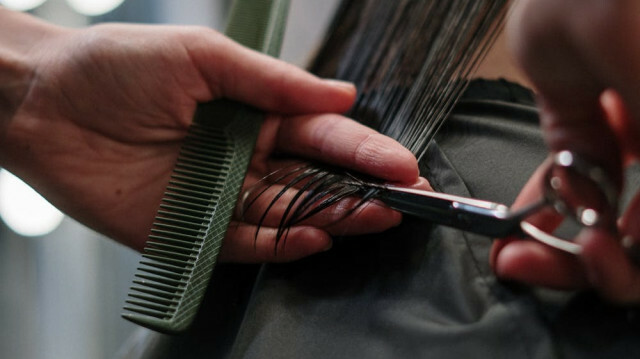
Milton Sabai giggles with excitement as he pulls a thin braid and ties it on his left toe, methodically twisting it to make long strands which he uses to weave on his clients’ scalps.
The 27-year-old Maasai warrior from Oldonyo Sambu village in Tanzania’s northern city of Arusha moves his hands with seamless dexterity as he briskly ties a new strand of braid.
“I never imagined that my plaiting skills would help me earn an income to support my family,” said Sabai, who runs a makeshift hairdressing stall in the Mwenge suburb on the outskirts of Dar es Salaam.
Sabai, who is married with one child, never imagined he would abandon his traditional way of life to spend hours weaving women’s hair, contrary to his tradition, to eke out a living.
“We have lost our grazing land. It’s being taken by powerful people. And due to the frequent drought, we can no longer sustain our way of life,” he said.
On a good day, Sabai can pocket up to 230,000 Tanzanian shillings (US$100) depending on the flow of customers.
“Most of my customers come here on Saturdays and Sundays. Others call me on the phone to make appointments,” he said.
- Burgeoning industry
Although hairdressing has attracted many young Maasai who initially worked as security guards to work in the burgeoning beauty industry, Sabai’s exceptionally great skills, speed and creativity have kept most of his competitors at bay.
“I charge between 25,000 to 35,000 Tanzanian shillings depending on the style and the customer’s preference,” he said.
According to him, the customer is supposed to purchase the braids and bear any other costs, such as buying colorful beads.
“Some of my customers will pay me more whenever they’re satisfied with my service,” Sabai said.
Sabai, who enjoys cracking jokes with his colleagues, said he keeps some of his money in mobile banking and frequently sends some to support his parents back in Oldonyo Sambu.
“I don’t want to forget where I came from. I know I have a duty to help my parents and relatives at home,” he said.
As one of the most vibrant indigenous societies in East Africa, the Maasai pastoralists, who have traditionally maintained a nomadic lifestyle, are increasingly changing their livelihoods due to recurring drought spells that scientists say are triggered by the worsening impacts of climate change.
The lack of rain has prompted many young Maasai herdsmen to move to cities to find alternative work to meet the growing needs of their families.
For decades, Maasai pastoralists have lived a migratory lifestyle, and young morans, or warriors, who are armed with swords and sticks, have been responsible for protecting cattle from predators.
The Maasai, whose traditional diet heavily relies on milk and beef, have historically depended on cattle to meet all their basic needs.
- Threatened culture
The Maasai have since time immemorial been striving to protect their culture, which is increasingly threatened by modernity.
In the bustling suburb of Tegeta on the outskirts of Dar es Salaam, a group of young men in gleaming red lobes is huddled under the shade of the Haradari tree, anxiously waiting for customers.
As men and women are jostling for space, walking past hawkers who display piles of women’s second-hand clothes in a maze of wooden stalls, Lengai Maneno is busy rolling thin braids with a silky texture on his thigh to prepare them for the next customer.
“I am getting used to this work. It doesn’t take long to twist them. It is easier that way,” he said with a grin.
The 39-year-old Maasai moran, who is also married with three children, moved to Dar es Salaam eight years ago. He initially worked as a hawker selling bracelets and herbs before switching to hairdressing, which he considers more lucrative.
Perching his customer’s head between his thighs, Maneno pulls the strands back and forth as he attaches them on the scalp.
Barely a decade ago, this ebullient young man would be herding cattle in the dusty plains of the impoverished town of Boma Ng’ombe, along with his peers who were without income except for food.
Swathes of grazing land that were formally owned and managed collectively have apparently been grabbed by powerful investors to further commercial interests of the state such as establishing private ranches or wildlife tourism.
- Edge of survival
The Maasai, one of the world’s most renowned ethnic groups, whose people are known for their distinctive semi-nomadic lifestyle, bright-colored lobes and distended earlobes, have been pushed to the edge of survival due to the loss of grazing land to wildlife tourism and large-scale farming as well as recurrent drought spells, forcing some of them to move to cities.
The most notable activities of the Maasai in cities including hawking leather belts, wallets, bracelets, braiding women’s hair and selling concoctions of traditional herbs.
As drought continues to ravage most parts of northern Tanzania, hundreds of young Maasai men have abandoned their traditional lifestyle and headed to cities to find work.
Most of them, who are known for their sincerity, have secured jobs as night guards, hairdressers and herbalists with expertise on virtually all kinds of ailments.
Leishorwa Lepapa, who doesn’t know how to read or write, moved to Dar es Salaam from Loliondo in Arusha and has since been working as a hairdresser.
“When I came here, I did not have a place to live. I was sleeping in unfinished buildings. But I have now generated enough money to rent a room,” he said.
Lepapa, who learned the art of twisting braids shortly after his initiation into manhood, has no regrets over touching women’s hair, which is considered a taboo in wider Maasai culture.
“I wouldn’t dare to touch a woman’s head back at home. I would pay a heavy price,” he said.













